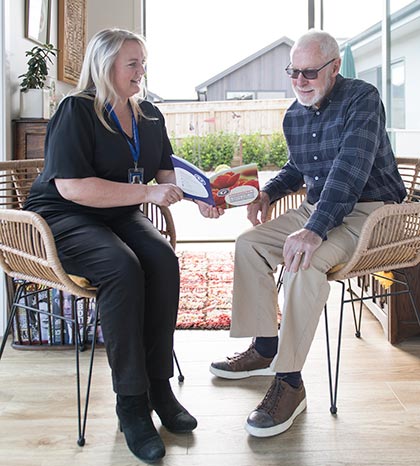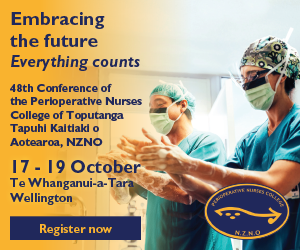
Parkinson’s New Zealand is a charitable trust employing more than 20 Parkinson’s nurses throughout the country. They provide support, education and information to people with Parkinson’s and Parkinsonism conditions, including their family, carers and health professionals.
Parkinson’s disease (PD) is named after English doctor James Parkinson, who first wrote about this condition in An Essay on the Shaking Palsy in 1817. Most people, when you say the words PD, think of the shaking, a resting tremor. Although this is synonymous with Parkinson’s, the disease is actually much more than shaking.
I started my nursing career many years ago at a regional neurology unit at Charing Cross Hospital in central London. How well I remember counting out those little light dapple-blue Sinemet tablets. After two years in different neurology units, my work took a different direction for some time. However, it was a move to New Zealand that led me back to where I started – my passion, neurology – in particular nursing people with Parkinson’s (PWP).
According to Parkinson’s UK, “Parkinson’s is the fastest growing neurological condition in the world, and currently there is no cure.”1
A study in New Zealand by senior research fellow Toni Pitcher and data scientist Daniel Myall from the University of Otago’s Brain Research Institute in Christchurch, shows the incidence of Parkinson’s is gradually increasing, from an estimated 7300 in 2006 to 10,700 in 2017.2 The researchers predict the number of PWP in New Zealand will increase in the next 25 years to 17,500 by 2035, and grow to 24,000 by 2068.2 There is ongoing research and several hypotheses as to why Pākehā – New Zealand Europeans – have the highest incidence, followed by the Asian, Pacific and Māori populations.3 Māori rates are the lowest among all ethnic groups.3
PD is a chronic progressive neurodegenerative condition caused by insufficient amounts of the chemical dopamine. Dopamine allows for fast, efficient, well-coordinated movements. PD has both motor and non-motor symptoms. It is more common in older people and in men than women.
The Parkinson’s Foundation states: “More than 10 million people worldwide are living with PD… Men are 1.5 times more likely to have PD than women.”4
PD often takes many years to develop and has little effect on life expectancy. Different people will experience a different number and combination of symptoms, which affect all aspects of daily life.5 It is relatively common, with approximately one in 500 people having the condition.4 It is believed one per cent of people above the age of 60 have Parkinson’s. It does not directly cause morbidity. However, associated complications, such as falls and pneumonia, are often associated with death.5
There are four main symptoms of Parkinson’s: tremor, bradykinesia, postural instability and rigidity. However, there are many other symptoms too – loss of smell (often an early sign), impaired posture and balance (PWP often present with the classical stoop), and loss of automatic movements, such as blinking, smiling or moving of arms. PWP can experience speech and swallowing changes, and writing can become very small.
The non-motor symptoms can be particularly debilitating. These can include fatigue, mood disorders (depression and anxiety), constipation, sleep and urinary problems, orthostatic hypotension, weight loss, problems with vision, cognitive changes, hallucinations, delusions and pain.6 With so many variable symptoms, it is an extremely individual disease which can be incredibly challenging to manage. No two people present in exactly the same way with symptoms or disease progression.
Treatment focuses on managing symptoms. Levodopa, which was developed back in the 1960s, is still considered the gold standard for treatment of Parkinsonian symptoms. Other medications include dopamine agonists, monoamine oxidase-B (MAO-B) inhibitors, amantadine and anticholinergics. It is very common for PWP to take a number of these throughout the day. Timing of medication is crucial to provide the greatest benefit.7
Surgical option
Deep brain stimulation is a surgical option used to treat PD when medication is no longer controlling symptoms. It uses mild electrical pulses through planting electrodes in the brain. These stimulate precisely targeted areas to treat PD symptoms. Although reversible, deep brain stimulation is not a cure and not suitable for everyone. It is usually most effective at improving tremors, slowness of movement and stiffness of joints. In New Zealand, it is carried out on fewer than 20 patients a year.
In most cases, the cause of Parkinson’s is idiopathic (unknown). Most research points to a number of combined factors. It is believed there is a strong genetic element in about 30 per cent of cases, but not all who carry these genetic mutations will get PD. Researchers believe other factors, such as environment and age (the biggest risk factor), all have a combined effect on whether the disease develops.8
There is ongoing research and several hypotheses as to why Pākehā – New Zealand Europeans – have the highest incidence of PD.
Recent research suggests that vigorous exercise has a neuroprotective effect in PD. Exercising helps PWP use the dopamine they have more efficiently and can slow disease progression. No drugs to date have been proven to have this effect. Everyone with Parkinson’s should exercise and research supports a variety of exercises, such as walking, boxing and dancing.9
Nurses a valuable resource
Parkinson’s New Zealand’s team of nurses across the country support people in our communities. Parkinson’s nurses visit clients in their own homes, providing individualised advice through personal assessment. PWP are best seen in their own home environment, as they are frequently frail, and the severity of their symptoms fluctuates and changes rapidly during the course of the day. This can make attending appointments off-putting and difficult for them.
PWP are at high risk of hospital admission, but by regular contact with their clients, Parkinson’s nurses are able to identify risks and intervene early to prevent these crisis admissions. A multidisciplinary approach is needed to manage a PWP effectively.10
The work of Parkinson’s nurses is extensive. They support the client, their family and carers by giving information and support to an agreed plan that promotes best health and lifestyle. They also work closely with GPs, specialists and other health-care professionals. They advise, liaise and make referrals to services such as speech and language therapy, physiotherapy and occupational therapy and act as a resource for health-care professionals, providing education sessions as needed.
Parkinson’s New Zealand nurses are there for the wellbeing of the person living with Parkinson’s, providing professional support, information and advocacy. They work across the country and are a valuable resource, not only for their clients, but for all health-care professionals, who are helping navigate someone on their Parkinson’s journey.
I am passionate about my role and the great Parkinson’s nursing team I am fortunate to work with. Since I began writing this article, our world has changed immensely. The COVID-19 lockdown temporarily stopped face-to-face Parkinson’s nurse home visits. Spreading globally, COVID-19 is a new viral illness and, as a result, we don’t yet have accurate information about what its impact might be on those with PD.
COVID-19 poses greater risk
Although the Ministry of Health has not as yet specified that PWP and Parkinsonism conditions are a high-risk group, the National Health Service in the United Kingdom has identified PWP as being at greater risk of severe morbidity or mortality should they get COVID-19. This is due to the numerous implications for PWP that coronavirus poses.11 This sentiment is shared by a variety of Parkinson’s leaders across the world.12
During these challenging times, our nurses remain committed to staying in touch with people who need our care more than ever. Whether by email, phone or video link, Parkinson’s nurses are continuing to provide support and advice to our clients, families and carers.
Claire Fisher, RN, is the team leader for clinical services at Parkinson’s New Zealand.
References
- Parkinsons UK. (2020, February 15). Reporting on Parkinson’s as a journalist.
- Myall, D. J., Pitcher, T. L., Pearson, J. F., Dalrymple-Alford, J. C., Anderson, T. J., & MacAskill, M. R. (2017). Parkinson’s in the Oldest Old: Impact on Estimates of Future Disease Burden. Parkinsonism and Related Disorders, 42, 78-84.
- Pitcher, T. L., Myall, D. J., Pearson, J. F., Cameron, J. L., Dalrymple-Alford, J. C., Anderson, T. J., & MacAskill, M. R. (2018). Parkinson’s disease across ethnicities: a nationwide study in New Zealand. Movement Disorders, 33(9),1440-1448.
- Parkinson’s Foundation. (2020). Understanding Parkinson’s. Statistics.
- Geirge DeMaagd, A. P. (2015). Parkinson’s Disease and its management: Part 1: Disease Entity, Risk Factors, Pathophysiology, Clinical Presenatation, and Diagnsois. Pharmacy and Therapeutics, 40(8), 504-532.
- Mayo Clinic. (2020). Parkinson’s Disease.
- Parkinson’s Foundation. (2020). Understanding Parkinson’s. Treatment.
- The Michael J. Fox Foundation. (2020). About Parkinson’s. Causes.
- Ahlskog, J. E. (2011). Does vigorous exercise have a neuroprotective effect in Parkinson disease? Neurology, 77(3) 288-294.
- Qamar, M. A. (2017). Multidisciplinary Care in Parkinson’s Disease. International Review of Neurobiology, 132, 511–523.
- NHS. (2020). People at higher risk from coronavirus.
- American Parkinson Disease Association. (2020). Coronavirus Disease 2019 and the PD Community.



